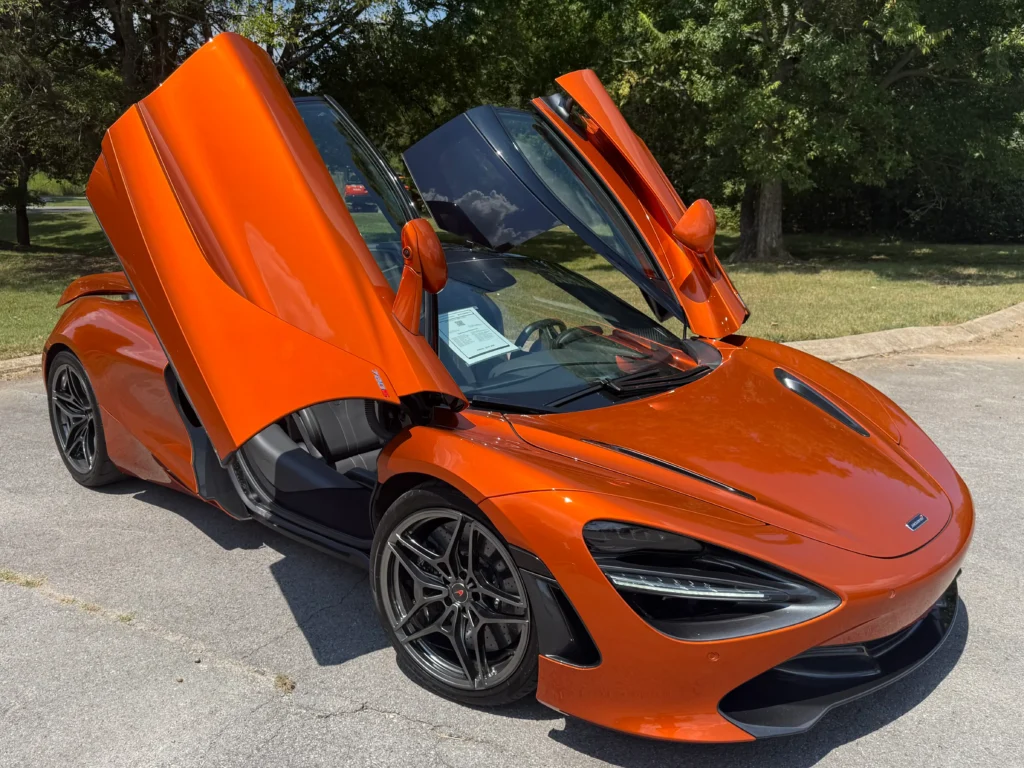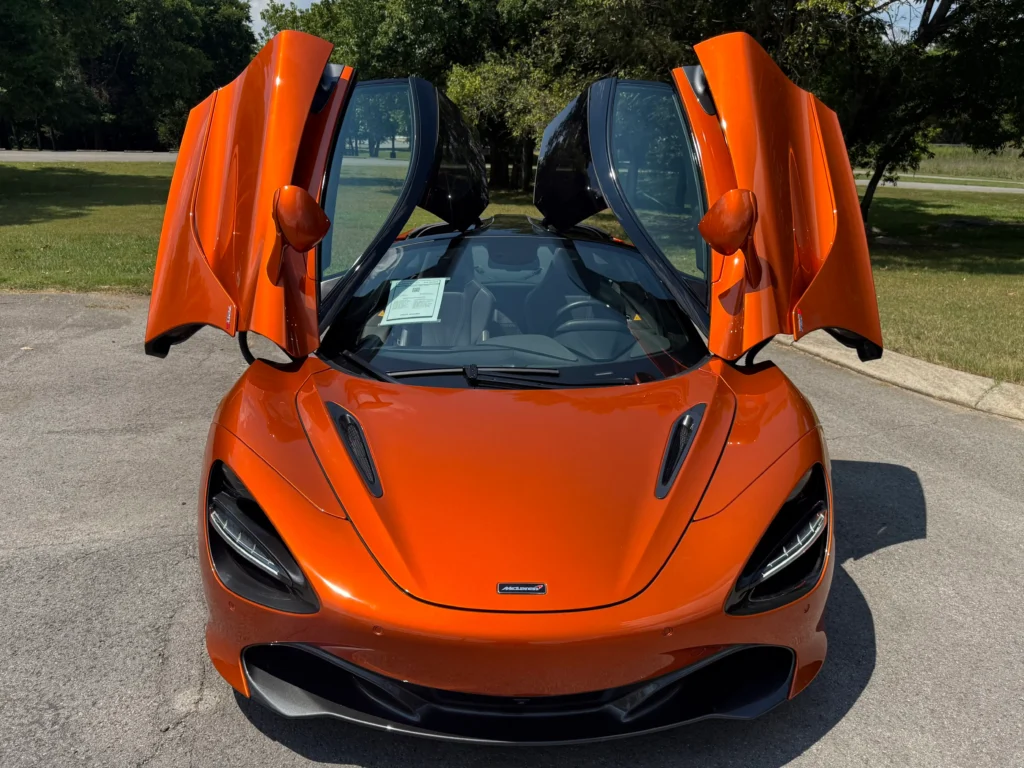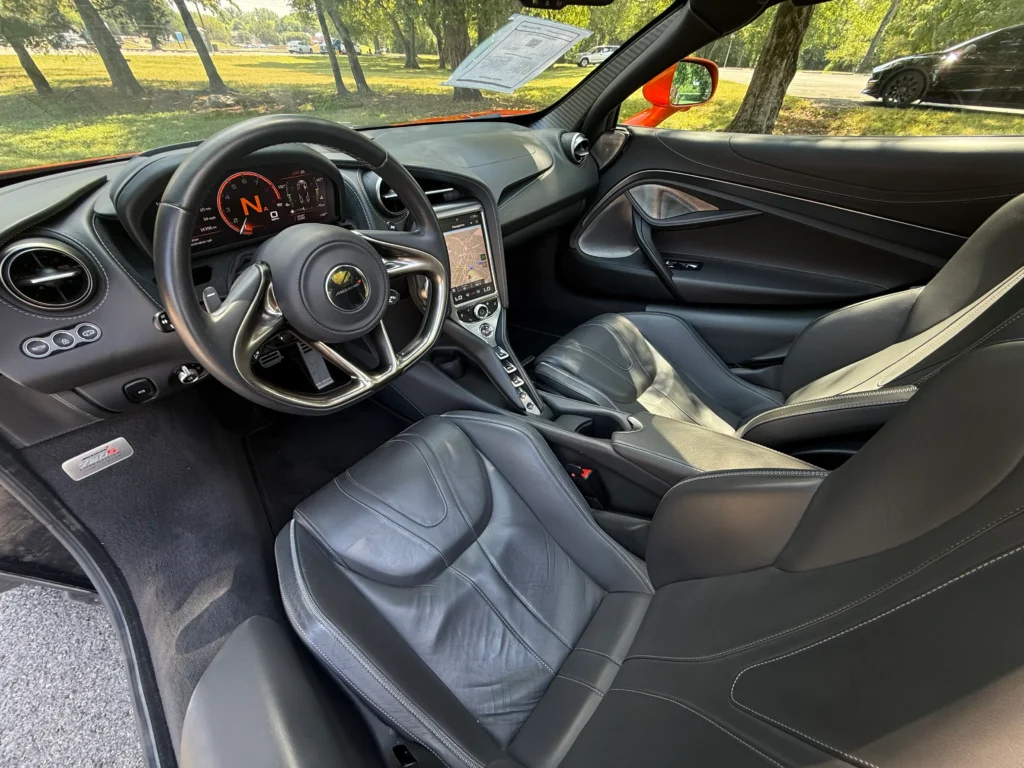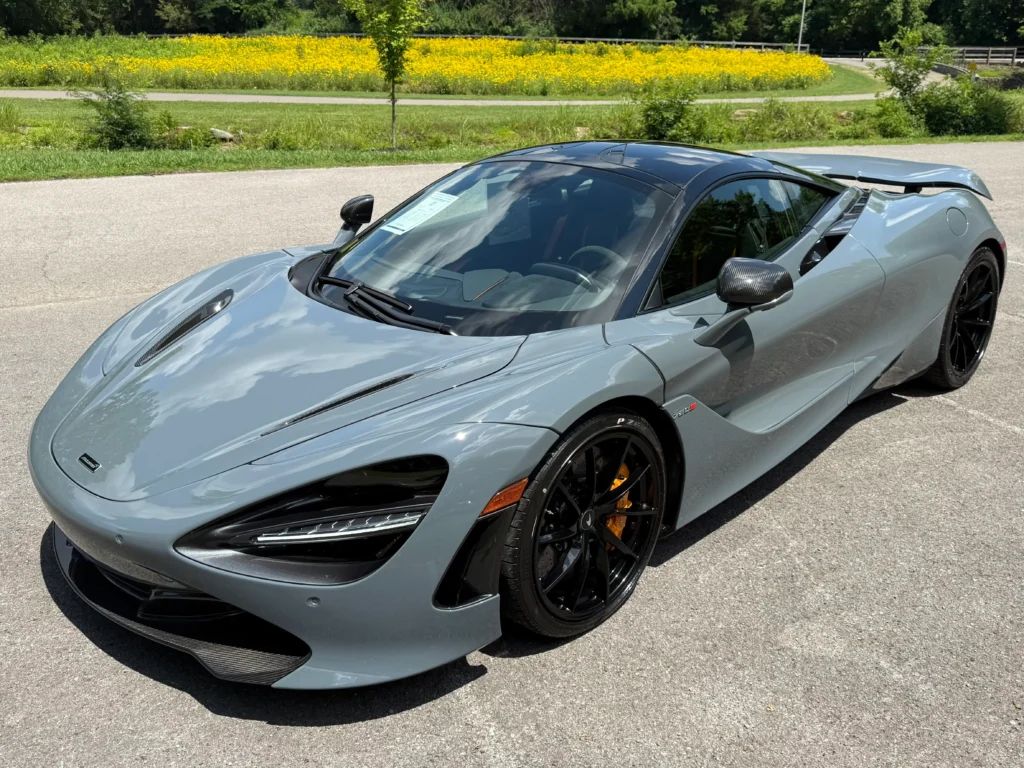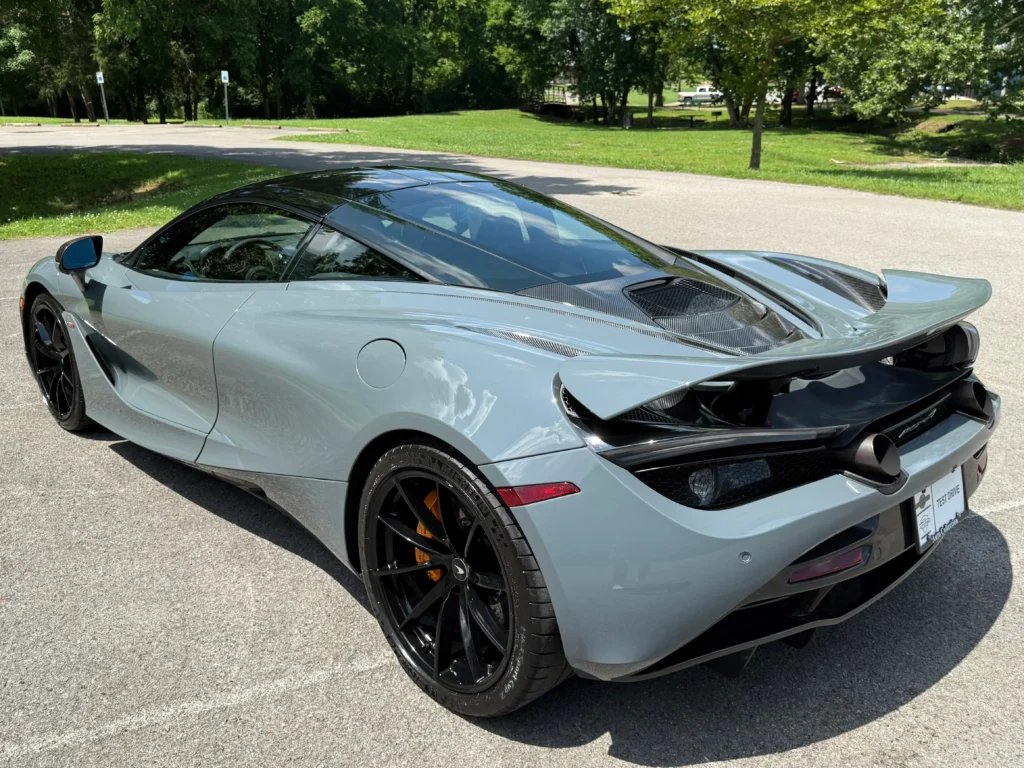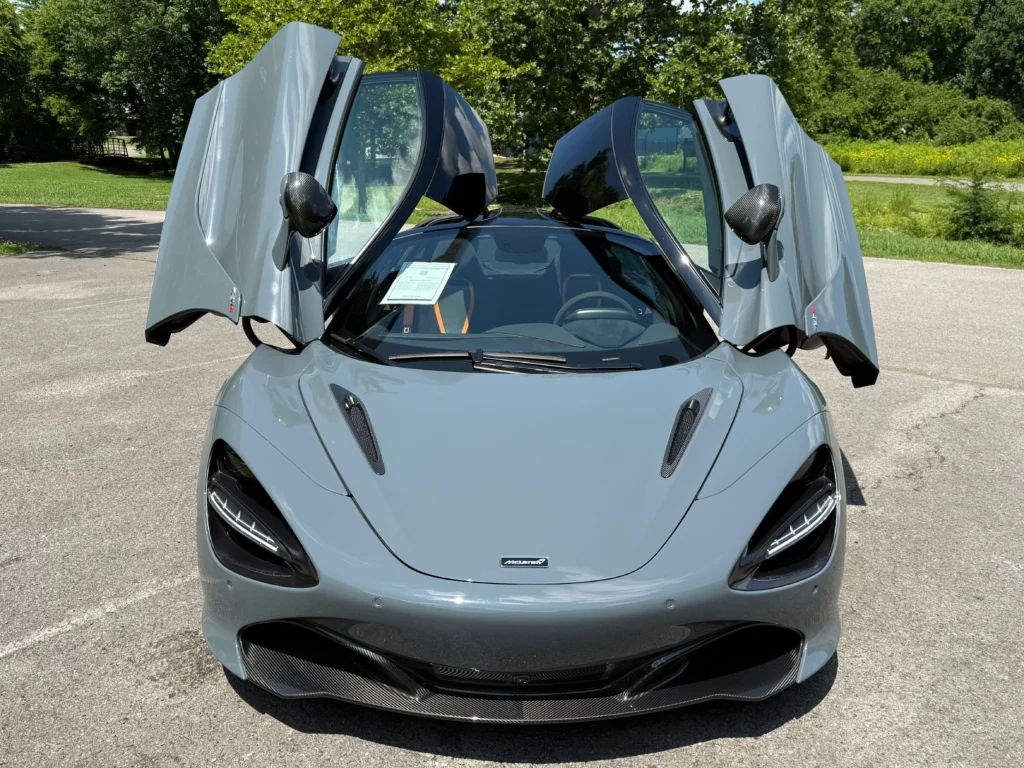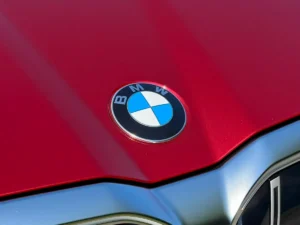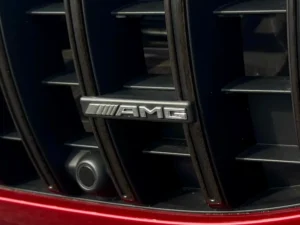Ever dream of owning a supercar that looks like it belongs in a sci-fi movie but actually works on real-world roads? That’s the McLaren 720S — and yes, the 720S Spider too. Across the U.S., where car enthusiasts appreciate both performance and design, the 720S lineup turns heads with its wild dihedral doors, spaceship-like cockpit, and a twin-turbo V8 that rockets from zero to 60 mph in just 2.8 seconds.
The best part? Buying a used McLaren 720S or 720S Spider is smarter than you think. Depreciation knocks down the price, but you still get the full supercar experience for a fraction of what the first owner paid.
Table of Contents
Model History & Evolution
The McLaren 720S debuted in 2017 as the next step in McLaren’s Super Series, replacing the 650S. Its name comes from its 720 metric horsepower—that’s 710 hp for us in the U.S.—and it introduced the world to McLaren’s Monocage II carbon fiber tub, making it lighter and stiffer than its predecessor.
Key Milestones
2017 – Launch Year:
- Debuted at the Geneva Motor Show.
- Featured the 4.0L twin-turbocharged V8 producing 710 hp.
- Introduced dihedral doors and the folding digital driver display.
2018 – Early Reception:
- Critics praised its insane speed and surprisingly comfortable ride.
- Owners noted occasional infotainment quirks and minor suspension issues.
2019 – 720S Spider Arrives:
- McLaren launched the 720S Spider with a retractable hardtop that added open-air thrills without sacrificing the car’s 2.8-second 0–60 mph time or 212-mph top speed.
- The Spider’s design barely added weight thanks to clever engineering, keeping the same sharp handling as the coupe.
- It quickly became a favorite for its drama, versatility, and slightly stronger resale value.
2020–2021 – Refinements:
- Ongoing software tweaks improved infotainment response.
- Early mechanical reliability issues were largely ironed out.
Today, both the 720S Coupe and Spider are celebrated for delivering track-level performance with real-world comfort—a rare combo in the supercar world.
Specs, Trims, and Real-World Features
If you’re considering a used McLaren 720S, understanding the specs and trim differences is crucial to choosing the right fit for your driving style and priorities. From the raw performance numbers to the available interior packages, knowing what each version offers helps you make an informed choice. This section breaks down both the 720S Coupe and Spider variants, their trims, optional packages, and real-world insights to guide buyers navigating the used exotic car market.
McLaren 720S Coupe Specs
The 720S Coupe is the ultimate blend of lightweight engineering and blistering speed:
- Engine: 4.0L twin-turbo V8
- Power: 710 hp, 568 lb-ft torque
- 0–60 mph: ~2.9 seconds
- Top Speed: 212 mph
- Transmission: 7-speed dual-clutch automatic
- Chassis: Carbon-fiber monocoque for extreme rigidity
- Brakes: Carbon-ceramic, adaptive suspension
This combination makes the 720S a precision supercar that feels explosive on straights and razor-sharp in corners.
McLaren 720S Coupe Trims
- Base (Standard):
- Essentials like carbon-ceramic brakes, adaptive dampers, keyless entry, and signature dihedral doors.
- 7-inch touchscreen, dual-zone climate control, Alcantara accents. Lightest and most performance-focused.
- Luxury:
- Full leather interior, heated power seats, ambient cabin lighting, and extra sound insulation. Offers a smoother, more grand-touring experience.
- Performance:
- Track-focused touches: carbon-fiber interior trim, Alcantara racing seats, engine-bay lighting. Combines daily usability with hardcore performance styling.
Optional packages like the Convenience Pack (vehicle lift, 360° park assist, premium audio) and MSO Track Pack (lightweight seats, telemetry system, forged wheels) let buyers tailor the car for comfort or track performance.
McLaren 720S Spider Specs
The Spider is the convertible sibling of the Coupe, offering open-air thrills with almost no compromise:
- Engine: Same 4.0L twin-turbo V8
- Power: 710 hp, 568 lb-ft torque
- 0–60 mph: ~2.8 seconds
- Top Speed: 212 mph (roof up), 201 mph (roof down)
- Roof System: Retractable hardtop opens/closes in 11 seconds at speeds up to 31 mph
- Weight: ~108 pounds heavier than the Coupe
- Chassis & Handling: Carbon-fiber monocoque ensures rigidity and cornering precision despite extra weight
McLaren 720S Spider Trims
Just like the Coupe, the Spider is available in:
- Base Spider: Essentials plus lightweight performance
- Luxury Spider: Softer interior, heated seats, ambient lighting
- Performance Spider: Track-ready styling and carbon-fiber enhancements
Optional packages are the same as the Coupe, allowing customization for comfort, tech, or track performance.
Real-World Insight: McLaren 720S Base Coupe
Many buyers recommend the Base Coupe with a few well-chosen options:
The standard 720S gives you everything that makes the car magic—lightweight chassis, monster engine, adaptive suspension—without piling on extras you may never use. Add the lift system and upgraded audio, and you’re set for both daily drives and track days.
It’s widely considered the best balance of performance, usability, and value in the used 720S market.
For another perspective on the McLaren 720S, Top Gear offers their own take on the car’s performance and design.
Buying Guide & Competitive Analysis
If you’re thinking seriously about owning a McLaren 720S, there’s more to it than just the thrill of opening those iconic dihedral doors. This section walks you through what to check before buying, the real costs of ownership, and how the 720S compares to rivals like the Ferrari 488 GTB, Lamborghini Huracán, and Porsche 911 Turbo S — plus tips on which years offer the best balance of value and reliability.
Pre-Purchase Inspection & Ongoing Maintenance
Before signing on the dotted line, be ready to:
- Book a Pre-Purchase Inspection (PPI) with an exotic especially one familiar with McLaren’s hydraulic systems.
- Double-check for infotainment glitches, occasional electrical quirks, or hydraulic suspension fault warnings.
- Factor in upkeep costs: annual services, hydraulic repairs, brakes (especially carbon-ceramic), tires, and possible infotainment updates or fixes.
These aren’t dealbreakers—but they’re part of the real-world reality of owning a supercar.
Ownership Insights
Many current 720S drivers report:
- Great performance with a surprising level of daily comfort.
- Occasional annoyance with infotainment responsiveness.
- Occasional minor bug fixes—like resetting door sensors or updating display software.
- A general sentiment of, “Yes, it’s expensive—but it’s worth it for the thrill and exclusivity.”
Best Year to Buy
If you’re after both reliability and value, here’s what typically comes up:
- 2019–2021 models tend to be the sweet spot.
- Any early “quirks” are usually ironed out by this point.
- Many late-2018 and 2019 cars still have residual factory warranty—great for peace of mind.
- Later model years (2020, 2021) may offer more refined infotainment and suspension tweaks.
- If you find a 2017 or 2018 720S, make sure full service history is present and that the hydraulic system has been thoroughly checked.
McLaren 720S & 720S Spider vs. the Supercar Elite: Ferrari 488, Huracán, and 911 Turbo S
When you’re weighing the McLaren 720S or the 720S Spider against rivals like the Ferrari 488 GTB, Lamborghini Huracán, and Porsche 911 Turbo S, the differences go beyond raw horsepower. Buyers often care about real-world factors—like resale value, driving comfort, tech features, and ownership costs—just as much as acceleration times. Below, we break down the key metrics to help you see where each car shines.
| Model | Performance (0–60 mph) | Horsepower | Driving Experience | Interior Quality | Tech Features | Resale Value | Maintenance Costs |
|---|---|---|---|---|---|---|---|
| McLaren 720S | ~2.8 sec | 710 hp | Track-focused yet refined | Minimalist luxury | McLaren IRIS system | Moderate (depreciates fast first 3 yrs) | High (specialized service) |
| McLaren 720S Spider | ~2.9 sec | 710 hp | Same as 720S + open-air fun | Same as 720S | Same as 720S | Slightly better than 720S (collectibility factor) | High (even pricier repairs) |
| Ferrari 488 GTB | ~3.0 sec | 661 hp | Balanced, exotic feel | Premium, more polished | Advanced infotainment | Strong (Ferrari brand holds well) | Very High (Ferrari service costs) |
| Lamborghini Huracán | ~2.9 sec | 602–631 hp | Wild, emotional drive | Flashy, high-quality | Simple but effective | Moderate | High |
| Porsche 911 Turbo S | ~2.6 sec | 640 hp | Fast & usable daily | Top-notch build quality | Best infotainment here | Excellent (best in class) | Moderate (Porsche network easier) |
Honest Takeaway for Shoppers
If you want sheer performance and exotic presence, the McLaren 720S Coupe gives you the most speed for the money, with blistering acceleration and lighter weight than most rivals. The 720S Spider keeps nearly all that performance while adding open-air driving, though you’ll pay a little more and give up a bit of rigidity.
The Ferrari 488 GTB offers a higher resale value and a more emotionally charged driving experience—plus Ferrari’s prestige badge still carries weight.
The Lamborghini Huracán is the most aggressive-looking of the bunch, with a screaming V10 and simpler ownership costs than the McLaren or Ferrari, though its interior tech lags behind.
The Porsche 911 Turbo S is the everyday supercar—fast, all-weather capable, and surprisingly practical. It holds value well and is easier to maintain than the Italian exotics.
Bottom line:
- Pick the 720S Coupe for ultimate performance per dollar.
- Choose the 720S Spider if you want that same thrill with open-air freedom.
- Ferrari = resale value + prestige.
- Lamborghini = wild style + simpler ownership.
- Porsche = practicality + all-weather usability
Why Buying Used Makes Sense
- Depreciation does the heavy lifting for you: a two- or three-year-old 720S can cost tens (or hundreds) of thousands less than new—while still delivering supercar-level speed and exclusivity.
- If the car has detailed service records and passes the PPI, you’re likely getting a performance bargain—especially if you value handling finesse and lightweight engineering.
What to Look for in a Quality Dealership
Before choosing where to buy your McLaren, look for:
Transparent vehicle history reports and consistent service documentation.
Warranty or certified pre-owned options.
Flexible test-drive policies that let you experience the car in real-world conditions.
Positive customer reviews and a knowledgeable team.
Financing support tailored to performance or exotic cars.
AutoPro Nashville is one dealership that checks these boxes—known for its transparency, expertise, and dedication to helping drivers find the right high-performance vehicle.
Explore our full lineup of pre-owned McLaren 720S models here.
What are the main differences between the McLaren 720S Coupe and the 720S Spider?
The Spider adds a carbon-fiber retractable roof, about 108 pounds of weight, and open-air driving capability. Otherwise, the Spider retains the same 710 hp engine and most performance specs—0–60 in roughly 2.9 seconds, and up to 212 mph with the roof closed. It’s the same blistering performance, just with the thrill of wind in your hair.
What are the most common problems noted by used 720S owners?
Typical complaints include:
- Infotainment glitches like frozen screens or slow response
- Hydraulic suspension fault warnings or minor leaks
- Battery drainage if the car sits unused
- Door latch and sensor issues
These aren’t dealbreakers—they’re manageable if spotted early in a Pre-Purchase Inspection (PPI).
What is the annual maintenance cost for the 720S?
Expect $2,400–$3,500 per year for routine maintenance in the U.S., depending on service provider, location, and usage. Major repairs, like brakes or hydraulic components, will add extra costs.
Does the 720S Spider have extra upkeep compared to the Coupe?
Yes. The retractable roof adds complexity and weight, which may mean higher maintenance costs—especially if roof components or sensors misbehave.



